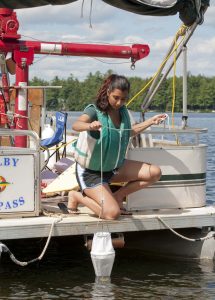Colby Team Builds Sustainability Coalition in Belgrade Lakes Region
 With water quality in slow decline and development pressure challenging already fragile ecosystems, basic measures are needed to save the Belgrade Lakes Watershed from serious harm and the resulting economic consequences.
With water quality in slow decline and development pressure challenging already fragile ecosystems, basic measures are needed to save the Belgrade Lakes Watershed from serious harm and the resulting economic consequences.
A team from Colby College realized that before phosphorous pollutants and algae blooms could be purged from the lakes and more rigorous development standards instituted, the region needed an effective system to make sustainability a real option
Working on a grant funded through the Sustainability Solutions Intiative (SSI) at UMaine’s Senator George J. Mitchell Center for Sustainability Solutions (Mitchell Center), D. Whitney King and colleagues spent five years advancing toward that goal. King, Miselis Professor of Chemistry at Colby, knew there were efforts underway by the state and community organizations to improve water quality and protect the region’s economy. He also knew a centralized infrastructure would be necessary to organize and amplify those stakeholder efforts.
“Our most important work was with the community and conservation professionals in the Belgrades,” King said. “What this project let us do is pull all of those efforts together and structure them into a system which is going to pay dividends for years.”
Maine lakes are big business. The state’s 5,700-plus freshwater bodies pump an estimated $2.5 billion into the state’s economy every year. With seven major lakes and 13 communities, the Belgrades are an important economic engine in central Maine. But the watershed is in trouble. Phosphorus pollution from development and human activity have triggered algae blooms that kill fish, harm aquatic ecosystems and destroy the water clarity that drew people to the lakes in the first place. The biggest problem stems from the suburbanization of lakefront landscaping. Erosion of camp roads, lawns and landscaping into the lake results in too much phosphorus entering the watershed. Research and practice have shown that using of winding paths, a buffer of trees and shrubs and a barrier of ground cover along the shore can drastically reduce lake pollution.
If changes don’t happen, state and local officials fear property values in the region could be significantly impacted.
Supporting lake conservation is the innovative Maine Lakes Resource Center (now the 7 Lakes Alliance) in Belgrade Village. Founded in conjunction with Colby, the Belgrade Lakes Association (BLA) and the Belgrade Regional Conservation Alliance (BRCA), in addition to other associations and community members, the MLRC has a mission to make homeowners and community stakeholders engaged as stewards of sustainability.
“We want to give property owners a path to success,” King said. “We want the community to have a relationship with the watershed.
A good example of this principle at work is the Maine Lakes Society’s (now Maine Lakes) adoption and management of the Maine Department of Environmental Protection’s (DEP) LakeSmart program. The LakeSmart program trains members of community groups as coordinators and property screeners. These volunteers work closely with homeowners, helping them to make changes to their lakefront lots that will help restore and preserve natural lake ecosystems. Property owners who make necessary improvements receive blue and white Award signs to be posted at shorefront and roadside. They read: “Living Lightly on the Land for the Sake of Our Lake.”
Colby’s involvement with MLRC and conservation efforts in the Belgrades will continue beyond the end of the SSI grant this fall, King said. Among the other important work done during the five-year grant period:
- Researchers compiled a database of shoreline habitat photographs and conducted extensive habitat surveys in documenting landscaping best practices for reducing human impacts to the lakes.
- The team completed a census of economic activity in the watershed, and documented stakeholder’s sense of place and preference for conservation-oriented shoreland amenities.
- Researchers completed extensive surveys of lake water quality providing a benchmark for measuring ecosystem improvement with expanded conservation efforts.
- The team installed and operates the water quality buoy, Goldie, a real-time sentinel of water quality in Great Pond.
As the SSI portion of the research wraps up, King and colleagues are working on several academic papers connected to the project. He said the opportunity for Colby to engage in this long-term sustainability science endeavor has served the college well: “This project helped us attract and retain junior faculty. This kind of collaborative work makes us much more appealing to new faculty looking for interdisciplinary research opportunities.”
Supported by National Science Foundation award EPS-0904155 to Maine EPSCoR at the University of Maine.
Other Resources:
- Sustaining Our Lakes project at UMaine’s Senator George J. Mitchell Center for Sustainability Solutions
